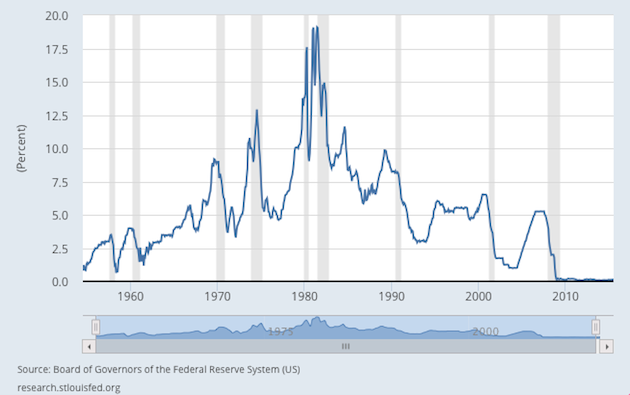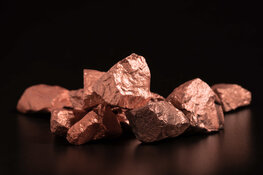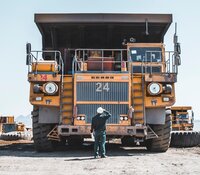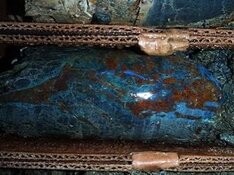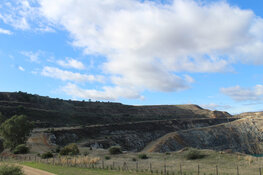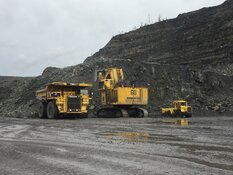The Gold Report: On Dec. 16, the U.S. Federal Reserve, as expected, raised its benchmark interest rate by 25 basis points. Somewhat unexpectedly, gold rallied on the news. In its year-end report, the World Gold Council, along with a number of experts who have talked to The Gold Report in the last year, said its research shows that higher interest rates are not necessarily bad for gold. Do you concur?
Charles Gibson: This rise in interest rates had been flagged for some time by the Federal Reserve; it was almost market orthodoxy that it was going to happen. The initial rally was a case of "sell on the rumor, buy on the facts," the reverse of the normal mentality. However, shortly after that, gold fell again. That, in part, was due to the fact that not only did the Fed put up the benchmark interest rate, it did so by the maximum amount, because there was some speculation that the rise might have been only 10 basis points. What continues to worry the market is Fed Chair Janet Yellen's statement that the Fed is looking at pushing the benchmark rate to 1.375% by the end of 2016, which suggests there are more interest rates rises to come over the next 12 months. That has renewed the nervousness in the market.
TGR: Why is the market nervous?
CG: The issue of interest rates is not as simple as looking at interest rates in general. You need to look at real interest rates. You can have interest rates high and rising, but if inflation were higher and rising faster, then you would expect gold to go up. I was one of the ones who thought the Fed didn't need to raise rates. My analysis suggested that at the current mean level of inflation, one would expect interest rates to be higher. However, 0–25 basis points was within the normal range. Given the direction that inflation has been moving recently, there didn't seem to be any pressure from an upward move.
" The amount of gold extracted at surface at Alkane Resources Ltd.'s Tomingley gold project exceeded expectations, and to me this highlights the strength of the mineralized system."
So I took the Fed's move to be political rather than economic. The Fed wants to head off the risk of inflation; however, with falling commodity prices and other signs, there seems to be little evidence of inflation in the economy. The Fed is trying to suggest a return to normality, but given the magnitude of what has happened in the eight years since the financial crash, we're still a long way from normality. That's where the potential interest in the gold market remains for the foreseeable future.
TGR: What rate of inflation would push gold higher?
CG: At 2% or above, we would still be in negative real interest rate territory. That makes hard assets an attractive proposition. The FTSE Index was above 7,000 earlier in the year but is now around 6,000. That would suggest a deflationary trajectory. If interest rates go up and inflation continues to fall, the outlook is probably more choppy for gold because falling inflation and rising real interest rates has historically created headwinds for gold.
TGR: As you watched Federal Reserve Chairman Janet Yellen deliver her speech at the Fed's press conference on Dec. 16, what were some of your thoughts as a gold investor?
CG: For a long time the Fed has had to surf a difficult wave, and it has admittedly surfed it quite well, yet it's being slightly disingenuous with the market. The Fed seems to determine the entire mood and direction of the market, whereas once upon a time it created the background. These days everyone seems to hang on every last comma of the Fed's pronouncements. That gives it enormous power and influence. It's also a dangerous position. By setting interest rate guidance at 1.375% by the end of 2016, the Fed could send the economy in the wrong direction for the sake of containing inflation. The economy's ability to sustain higher interest rates and higher real interest rates is very limited indeed.
TGR: As gold prices approach four-year lows, silver prices are testing multiyear lows. What's the thesis that pushes silver higher?
CG: Gold tends to perform better in an environment where the value of money is being questioned; silver tends to perform better in an environment where there is macroeconomic growth. For silver to outperform gold, we need to see evidence of growth among the major consuming nations like China. But at the moment, these metals are caught in an almost perfect storm where the Fed is raising interest rates, while China is dangerously close to a debt deflation spiral. So you have a major consuming nation consuming less at the same time that the Federal Reserve is making real hard assets less attractive as an investment proposition.
TGR: Does that mean investors should lean more toward defensive equity names at this point?
CG: In the current environment, one of the biggest headwinds for any company is financing. Assets that would have been financed three or four years ago might not get financed today. If you're invested in a company that can get financed, then obviously you stand to benefit from the upside, but you have to accept that there is a reasonable risk that it might not. Therefore, the sensible approach would be to go with a conservative asset allocation policy. Among the metals and mining equities, I would be inclined to direct investors toward secure, producing assets with limited funding risk.
TGR: What are some gold and silver equities that Edison Investment Research is following?
CG: Let me give you a couple that I like: Silver Wheaton Corp. (SLW:TSX; SLW:NYSE), a Canadian streaming company, and Pan African Resources Plc (PAF:AIM; PAN:JSE), a gold producer with mines in South Africa. Those two have good defensive characteristics in the current environment for commodities. In this market you want something that's going to give you solid defensive qualities if things get more difficult but could also ride any potential improvement in the market. Those two companies are well placed to perform those functions.
TGR: The Canada Revenue Agency (CRA) says Silver Wheaton owes the government millions in back taxes. Can it overcome those obligations without severely impairing its share price?
CG: First of all, Silver Wheaton is vigorously defending itself against the CRA's position and this will likely go to litigation. The amount the CRA is demanding works out to $0.66/share. By contrast, Silver Wheaton's shares are down a few dollars since the CRA announcement last July. That seems disproportionate. In addition (and the reason that Silver Wheaton is defending itself so vigorously), the CRA is seeking to reassess taxes on revenue streams from non-Canadian assets that go through a wholly owned but non-Canadian subsidiary. It's quite a stretch for the CRA to believe it can tax those assets.
"Silver Wheaton Corp. is a very attractive investment."
In any event, I would expect the share price to rise whether this issue is resolved positively or negatively. Even if it were to lose its case, which I don't think is likely, I can't see Silver Wheaton paying a full Canadian tax charge ad infinitum. So I would expect it to take action, which, again, would reduce that tax charge to something close to historical norms.
TGR: In a recent research report, you called Silver Wheaton "materially cheap" relative to its peers. Why?
CG: Its price-earnings and yield multiples are lower than virtually every other major royalty company listed in North America. It is actually cheaper than quite a few of the major mining companies, which, of course, have a higher risk profile. That makes Silver Wheaton a very attractive investment. The market is overemphasizing the current and future implications of the CRA's tax reassessment, which has resulted in a share price reaction that is disproportionately to the downside. Silver Wheaton was not expensive, but this move has made it noticeably cheap. Silver Wheaton is trading at a fraction of Franco-Nevada Corp.'s (FNV:TSX; FNV:NYSE) multiples, for example.
TGR: Pan African has two producing gold assets in South Africa and three non-producing assets there, too. Most companies eschew this jurisdiction in favor of less risky options, whereas Pan African is all in. Does that make sense?
CG: There is no such thing as a risk-free mining jurisdiction. Mining assets do not exist in risk-free countries.
TGR: But Pan African is exclusively exposed to South Africa.
CG: Yes, absolutely. But South Africa is close to the middle of the risk spectrum in the annual survey of mining jurisdictions published by Canada's Fraser Institute. I don't see South Africa as a high-risk environment. It's certainly not the most expensive jurisdiction. It has the advantage of the rand's depreciation versus the U.S. dollar, which will help Pan African's margins.
Another thing that sets it apart is that both the producing assets are roughly the same size. One is a Witwatersrand asset, which is a traditional South African asset. Barberton is not, however; it is a traditional greenstone mine. That makes a huge difference in terms of its depth, its risk profile. It also makes a huge difference in terms of its relationship with its mining unions. So, everything is different. It is also, within the South African mining industry, relatively small. Therefore, it tends to fly below the radar, which is very much in its favor. Meanwhile, it is making profits, generating cash flow and paying a generous dividend—with a yield approaching 10%, which I defy you to find anywhere else.
TGR: Is that why you believe it can get to 12.5 pence/share at current gold prices?
CG: Yes, essentially. But the other reason is the Evander asset in the famous Witwatersrand basin, which it bought a couple of years ago from Harmony Gold Mining Co. (HMY:NYSE; HAR:JSE). The mine has basically been reconfigured to concentrate on a high-grade pay shoot. The mine has been going through a low-grade cycle. In H2/15, it was mining at an average of 4.9 grams a ton (4.9 g/t). Over the course of the rest of this financial year, which runs until June 2016, the grade should come close to 7 g/t. That would make a colossal difference to its revenue, while costs effectively stay the same. So there's a huge amount of operational gearing to that grade recovery, which it's seeing at the moment.
TGR: Are there any other precious metals companies that you're following?
CG: Euromax Resources Ltd. (EOX:TSX.V) is one that springs to mind. It is developing the Ilovica copper-gold project in Macedonia. That has the advantage of being in Europe. Euromax has mandated banks for financing and has just produced a bankable feasibility study (early in 2016). This is basically the former management team of European Goldfields Ltd., which had a good track record of bringing assets to account in that part of the world. It's pre-engaging the engineers, contractors and banks in advance to seamlessly move through to final permitting, likely in mid-2016. It's about to go from explorer to producer—that's where most of the capital gains happen for investors.
TGR: Another company under coverage is Alkane Resources Ltd. (ALK:ASX; ANLKY:OTCQX), which just released a maiden reserve estimate on the Tomingley gold project in Australia. Do you think the company will be able to expand the resource? Does it warrant an underground operation?
CG: My colleague, Tom Hayes, covers Alkane. In general, resources are almost always expandable. Does it merit an underground operation? Over to Tom. . .
Tom Hayes: It has been a long-term objective of Alkane's to mine underground at the Tomingley gold project (the TGO), and the announcement of a JORC (Joint Ore Reserves Committee)-compliant reserve, undertaken as part of its TGO prefeasibility study, is a major step toward realizing that objective. In fact, when the TGO first started production, Alkane extracted more gold than it had originally estimated within the resource block model for one of its deposits. Further, due to JORC reporting guidelines, all Inferred material included in the pit designs needed to be set to a zero gold grade, but upon mining all Inferred ounces were 100% converted into production ounces. So the amount of gold extracted at surface exceeded expectations, and to me this highlights the strength of the mineralized system at the TGO. The TGO's gold endowment certainly does support an underground operation. It would not be a surprise to me if the amount of gold extracted underground at the TGO exceeded expectations again.
TGR: Lithium carbonate prices outperformed gold and silver this year by a wide margin. Do you expect the trend to continue in 2016 and beyond?
CG: By and large we do. Lithium has a tailwind in the form of a revolutionary shift to electric vehicles in the automotive industry as the world attempts to move away from fossil fuels, especially in the light of the tribulations that Volkswagen AG (VOW3:ETR) has had. Tesla Motors Inc.'s (TSLA:NASDAQ) Gigafactory in North America will play a significant role as lithium goes from being a specialized mined metal to something quite mainstream. That transition is transformative for the economic dynamics for lithium.
TGR: Do you have a preference between brine and hard rock lithium deposits?
CG: We've been looking at this issue. There is a perception that brines are the superior asset due to their size, and that is not necessarily true. The conversion of resources to reserves is often quite low with brine deposits if they are to be extracted using evaporation ponds, and when you take that conversion into account, it makes the sizes of brines similar to hard rock deposits. What is key is product purity because end-users have very high standards and need to be sure that the lithium used maintains adequate battery life.
TGR: Is there a lithium company you like?
CG: Rare Earth Minerals Plc (REM:LSE) is another company that Tom has looked at in great detail. Over to him. . .
TH: Rare Earth Minerals describes itself as an investment company, but has strategically positioned itself as a lithium play. At this time it has a 42% total economic interest in its flagship Sonora lithium project, along with majority owner Bacanora Minerals Ltd. (BCN:TSX.V). It also has equity stakes in European Metals, which owns the Cinovec lithium-tin project on the German-Czech Republic border, as well as in Western Lithium USA Corp. (WLC:TSX; WLCDF:OTCQX), which has the Kings Valley lithium project in Nevada, and the Cauchari-Olaroz lithium project in Argentina. Rare Earth Minerals also holds an interesting free-carried interest in an Australian rare earth play called Yangibana, owned by Hastings Technology Metals Ltd. (HAS:ASX), as well as 100% ownership of an exploration project in Greenland called Narsaq. The lithium assets are clearly the focus of Rare Earth Minerals' investment strategy at present, especially Sonora. Though the rare earths still hold value, we don't consider these interesting projects key to the company's investment case.
TGR: Can you speak in broad terms about the advantages of owning stakes in a number of different lithium projects versus the typical discover-and-develop model employed by most junior mining companies?
CG: Although Rare Earth Minerals has stakes in a number of assets, it definitely has a lead asset—the Sonora lithium project, about 200 kilometers north of Hermosillo, Mexico. Many companies appear as single-asset companies but they often have a number of other less-developed assets. They place the emphasis on one asset because it makes it a simpler story for the market to understand. Rare Earth Minerals is doing exactly that, though the intent here is more strategic. It's positioned itself as a lithium play. At the bottom of the last cycle, in 2000–2001 when virtually all mining assets were underperforming, the heavy mineral sands were the one exception where investors were making money. That situation looks similar to the current market environment for lithium. The market dynamic is in a secular uptrend. The opportunity for investors is to exploit mispriced assets.
TGR: What about the rare earth elements component of that story? Is this mostly a lithium play or do the rare earths hold some value too?
CG: They certainly hold some value. Over the last 10 years, the investment proposition for rare earths has proven difficult. The lithium story is much cleaner and easier to tell. Is there value in the rare earths? Yes, but there may be a relatively long burn in terms of realizing that value. I think it's more likely to come out in the wake of the development of the lithium assets.
TGR: Please give us a sentence that you expect will largely sum up the gold market in 2016.
CG: I think there is the possibility that some major, macroeconomic perceptions may change quite materially and quite rapidly.
TGR: Thank you for your insights, Charles and Tom.
A chemist by academic training, Charles Gibson spent a decade in the City of London as a mining analyst at Cazenove and a specialist mining salesman at T Hoare Canaccord, before joining Edison. He has extensive media experience, having written for MoneyWeek and The Business magazines, and The Evening Standard. Gibson is a leading authority on mining and continues to guest present for LBC on financial and business matters.
Tom Hayes has been a mining analyst at Edison Investment Research in London since 2010. He worked previously for the consulting firm Mouchel and has been a lead production geologist and resource definition geologist for mines in Australia and Saudi Arabia. He holds a Bachelor of Science from the University of Plymouth and a Master of Science in mining geology from the Camborne School of Mines.
Read what other experts are saying about:
Want to read more Gold Report interviews like this? Sign up for our free e-newsletter, and you'll learn when new articles have been published. To see recent interviews with industry analysts and commentators, visit our Streetwise Interviews page.
DISCLOSURE:
1) Brian Sylvester conducted this interview for Streetwise Reports LLC, publisher of The Gold Report, The Energy Report and The Life Sciences Report, and provides services to Streetwise Reports as an independent contractor. He owns, or his family owns, shares of the following companies mentioned in this interview: None.
2) The following companies mentioned in the interview are sponsors of Streetwise Reports: Alkane Resources Ltd. and Silver Wheaton Corp. Franco-Nevada Corp. is not affiliated with Streetwise Reports. The companies mentioned in this interview were not involved in any aspect of the interview preparation or post-interview editing so the expert could speak independently about the sector. Streetwise Reports does not accept stock in exchange for its services.
3) Charles Gibson and Tom Hayes: Neither I, nor my family, own shares in any of the companies mentioned in this interview. Neither I, nor my family, are paid by any companies mentioned in this interview. My company has a financial relationship with the following companies mentioned in this interview: Silver Wheaton Corp., Pan African Resources Plc, Euromax Resources Ltd., Alkane Resources Ltd. and Rare Earth Minerals Plc. I was not paid by Streetwise Reports for participating in this interview. Comments and opinions expressed are my own comments and opinions. I determined and had final say over which companies would be included in the interview based on my research, understanding of the sector and interview theme. I had the opportunity to review the interview for accuracy as of the date of the interview and am responsible for the content of the interview.
4) Interviews are edited for clarity. Streetwise Reports does not make editorial comments or change experts' statements without their consent.
5) The interview does not constitute investment advice. Each reader is encouraged to consult with his or her individual financial professional and any action a reader takes as a result of information presented here is his or her own responsibility. By opening this page, each reader accepts and agrees to Streetwise Reports' terms of use and full legal disclaimer.
6) From time to time, Streetwise Reports LLC and its directors, officers, employees or members of their families, as well as persons interviewed for articles and interviews on the site, may have a long or short position in securities mentioned. Directors, officers, employees or members of their families are prohibited from making purchases and/or sales of those securities in the open market or otherwise during the up-to-four-week interval from the time of the interview until after it publishes.

